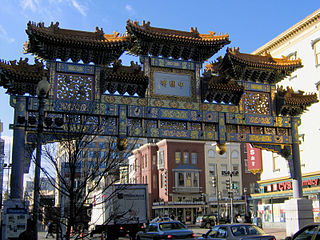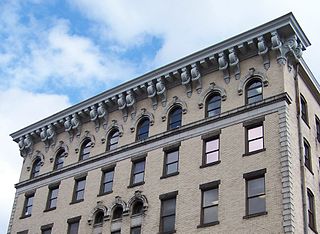
Dupont Circle is a traffic circle, park, neighborhood, and historic district in Northwest Washington, D.C.. The Dupont Circle neighborhood is bounded approximately by 16th Street NW to the east, 22nd Street NW to the west, M Street NW to the south, and Florida Avenue NW to the north. Much of the neighborhood is listed on the National Register of Historic Places. However, the local government Advisory Neighborhood Commission and the Dupont Circle Historic District have slightly different boundaries.

Embassy Row is the informal name for the section of Massachusetts Avenue, N.W. between Scott Circle and the North side of the United States Naval Observatory, in which embassies, diplomatic missions, and other diplomatic representations are concentrated. By extension, the name may be used to encompass nearby streets which also host diplomatic buildings.
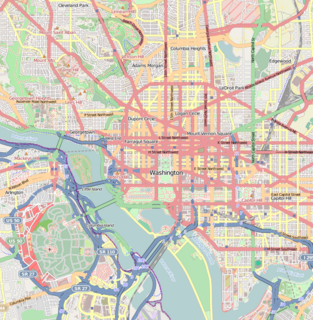
Mount Vernon Square is a city square and neighborhood in the Northwest quadrant of Washington, D.C. The square is located where the following streets would otherwise intersect: Massachusetts Avenue NW, New York Avenue NW, K Street NW, and 8th Street NW.

Massachusetts Avenue is a major diagonal transverse road in Washington, D.C., and the Massachusetts Avenue Historic District is a historic district that includes part of it.
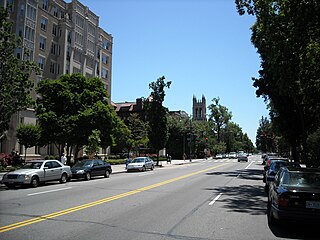
16th Street Northwest is a prominent north-south thoroughfare in the northwest quadrant of Washington, D.C. Part of the street is listed on the National Register of Historic Places as Sixteenth Street Historic District.

Petworth is a residential neighborhood in the Northwest quadrant of Washington, D.C. It is bounded to the east by the Armed Forces Retirement Home and Rock Creek Cemetery, to the west by Arkansas Avenue NW, to the south by Rock Creek Church Road NW and Spring Road NW, and to the north by Kennedy Street NW.
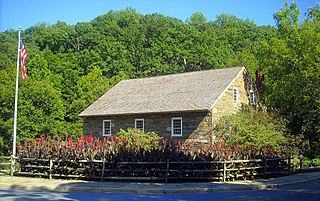
This is a list of properties and districts in the District of Columbia on the National Register of Historic Places. There are more than 600 listings, including 74 National Historic Landmarks of the United States and another 13 places otherwise designated as historic sites of national importance by Congress or the President.

Downtown is a neighborhood of Washington, D.C., as well as a colloquial name for the central business district in the northwest quadrant of the city. Geographically, the area extends roughly five to six blocks west, northwest, north, northeast, and east of the White House. Several important museums, theaters, and a major sports venue are located in the area. A portion of this area is known as the Downtown Historic District and was listed on the NRHP in 2001.

2000 Pennsylvania Avenue, also known as The Shops at 2000 Penn and Red Lion Row, is a shopping center and eight-story office complex located on Pennsylvania Avenue, NW in Washington, D.C. It forms a busy gateway into the main campus of the George Washington University, which owns the property. As the 2000 Block of Eye Street, NW, the houses were named a DC Landmark and added to the National Register of Historic Places, both in 1977.

The Samuel Gompers House is a historic house at 2122 1st Street NW, in the Bloomingdale neighborhood of Washington, D.C. Built around the turn of the 20th century, it was from 1902 until 1917 home to Samuel Gompers (1850–1924), who was founder and president of the American Federation of Labor from 1886 until his death. It was declared a National Historic Landmark in 1974.
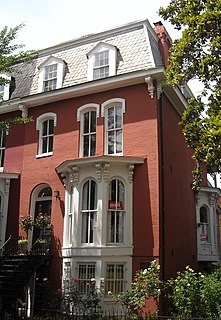
The Zalmon Richards House is a historic house at 1301 Corcoran Street Northwest in Washington, D.C.. A Second Empire rowhouse, it was home from 1882 until his death of Zalmon Richards (1811-1899), founder of the National Education Association. It was declared a National Historic Landmark in 1965. It is a private residence.

Charles Evans Hughes House is a historic house at 2223 R Street, NW in the Sheridan-Kalorama neighborhood of Washington, D.C.. Built in 1907, it was from 1930 to 1948 the home of Charles Evans Hughes (1862–1948), a prominent Republican politician and from 1930–1941 the Chief Justice of the United States. It was declared a National Historic Landmark in 1972 and is a contributing property to the Sheridan-Kalorama Historic District. It presently serves as the official residence of the Ambassador of Myanmar to the United States.

The David White House is a historic house at 1459 Girard Street NW in Washington, D.C.. A National Historic Landmark, it was the home of geologist David White (1862–1935) from 1910 to 1925. White had a longtime association with the United States Geological Survey (USGS), and performed groundbreaking research on peat and petroleum geology.
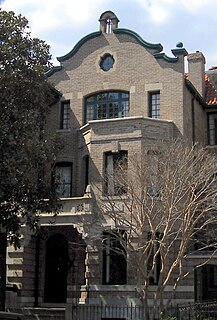
The L. Ron Hubbard House, also known as the Original Founding Church of Scientology, is a writer's house museum and former Scientology church located at 1812 19th Street NW in the Dupont Circle neighborhood of Washington, D.C., United States. Public tours are given on a regular basis. The operating Founding Church is now located at 1424 16th Street for services, bookstore and classes. The home served as the residence of Scientology founder L. Ron Hubbard from 1955 until 1959, during which time he incorporated the Founding Church of Scientology and performed the first Scientology wedding. The building is a contributing property to the Dupont Circle Historic District, a neighborhood listed on the National Register of Historic Places.

There are 65 properties listed on the National Register of Historic Places in Albany, New York, United States. Six are additionally designated as National Historic Landmarks (NHLs), the most of any city in the state after New York City. Another 14 are historic districts, for which 20 of the listings are also contributing properties. Two properties, both buildings, that had been listed in the past but have since been demolished have been delisted; one building that is also no longer extant remains listed.
Architect B. Stanley Simmons (1872–1931) was an American architect.
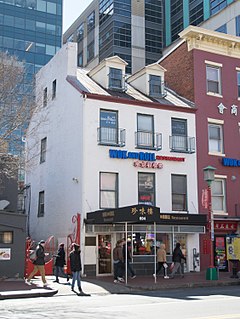
The Mary E. Surratt Boarding House in Washington, D.C. was the site of meetings of conspirators to kidnap and subsequently to assassinate U.S. President Abraham Lincoln. It was operated as a boarding house by Mary Surratt from September 1864 to April 1865.

The American Security and Trust Company Building is a Neoclassical bank office in Washington, D.C., designed by the architectural firm of York and Sawyer. It was listed on the National Register of Historic Places in 1973.

The Washington Heights Historic District is located in the Adams Morgan neighborhood of Washington, D.C.. The historic district includes 347 contributing properties that date from 1891-1950. It was listed on the National Register of Historic Places in 2006.

Mount Vernon Triangle is a neighborhood and community improvement district in the northwest quadrant of Washington, D.C. Originally a working-class neighborhood established in the 19th century, present-day Mount Vernon Triangle experienced a decline in the mid-20th century as it transitioned from residential to commercial and industrial use. The neighborhood has undergone significant and rapid redevelopment in the 21st century. It now consists mostly of high-rise condominium, apartment and office buildings. Several historic buildings in the neighborhood have been preserved and are listed on the National Register of Historic Places. Mount Vernon Triangle is now considered a good example of urban planning and a walkable neighborhood.

